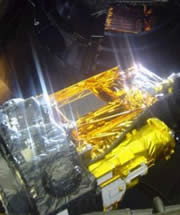Gamma rays from the center of the galaxy may be the signals of light particles, which may be dark matter.
Philip Ball, Nature (translation: Dikla Oren)

Astrophysicists claim that bursts of gamma rays from the center of the galaxy may be the signature of the mysterious dark matter. The gamma rays support an exotic theory about the nature of dark matter. The theory claims that it is composed of extremely light particles.
Physicists know that a significant part of the mass in the universe is not the objects we can see, such as stars and planets. Galaxies like ours may contain ten times as much dark matter as normal matter.
A common idea claims that the "missing" dark matter consists of unknown subatomic particles that are much heavier than normal atoms, but which have no interaction with normal matter except for gravity. They are called "weakly interacting massive particles" or for short WIMPS (Weakly Interacting Massive Particles).
Celine Boehm from the University of Oxford in England and her colleagues think that it is not necessary for the dark matter particles to be very massive. Instead, they think, these particles may be ten to ten thousand times lighter than a hydrogen atom.
Their evidence comes from data collected by the European Space Agency's INTEGRAL satellite, which scans the sky for gamma rays. The satellite mapped the cosmic sources of gamma rays with an energy of 511,000 electron volts (511 kiloelectron volts). Such gamma rays are about 200,000 times more energetic than visible light rays. They are formed when electrons and their antiparticles positrons ionize each other.
Last January, the Integral team announced that the gamma rays have an energy of 511 keV, their sources are evenly distributed in the central bulge region of our galaxy.
Interestingly, other observations of the effect of missing mass on stellar orbits indicate that dark matter is also concentrated in the central bulge of our galaxy.
Boehm's team claims that if dark matter consists of low-mass particles, these particles can create electrons and positrons in collisions with antimatter. When the electrons and positrons collide, the gamma rays are created.
The researchers calculated the number of particles needed to produce the gamma rays with an energy of 511 keV, which the integral saw. They found that the number matches the estimated amount of dark matter in our galaxy. "The numbers seem very reasonable," Boehm says. The team presents their work in the current issue of Physical Review Letters.
"It will be very exciting, if what they are saying turns out to be true," says Jürgen Knodelseder, a gamma-ray astronomer at the Center d'Etude Spatiale des Rayonnements in Toulouse, France, who used information from the integral.
Knodelseder warns, however, that it is not yet clear whether Boehm's dark matter theory is necessary. The source of the positrons may be exploding stars, called supernovae, rather than exotic particles. "Supernovae are still the most likely source of gamma rays," he says.
He suggests that accurate measurements of the scattering of gamma rays with an energy of 511 keV will help researchers decide whether they originate from dark matter or exploding stars.
